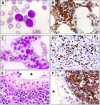A comparison of the International Consensus and 5th World Health Organization classifications of mature B-cell lymphomas
- PMID: 36460764
- PMCID: PMC9883170
- DOI: 10.1038/s41375-022-01764-1
A comparison of the International Consensus and 5th World Health Organization classifications of mature B-cell lymphomas
Abstract
Several editions of the World Health Organization (WHO) classifications of lympho-hemopoietic neoplasms in 2001, 2008 and 2017 served as the international standard for diagnosis. Since the 4th WHO edition, here referred as WHO-HAEM4, significant clinico-pathological, immunophenotypic and molecular advances have been made in the field of lymphomas, contributing to refining diagnostic criteria of several diseases, to upgrade entities previously defined as provisional and to identify new entities. This process has resulted in two recent classifying proposals of lymphoid neoplasms, the International Consensus Classification (ICC) and the 5th edition of the WHO classification (WHO-HAEM5). In this paper, we review and compare the two classifications in terms of diagnostic criteria and entity definition, with focus on mature B-cell neoplasms. The main aim is to provide a tool to facilitate the work of pathologists, hematologists and researchers involved in the diagnosis and treatment of lymphomas.
© 2022. The Author(s).
Conflict of interest statement
BF is co-signer of the ICC classification of lymphoid neoplasms. SL is co-signer of the 5th WHO classification of lymphoid neoplasms. GM has no relevant conflict of interest concerning this report.
Figures





References
-
- Harris NL, Jaffe ES, Stein H, Banks PM, Chan JK, Cleary ML, et al. A revised European-American classification of lymphoid neoplasms: a proposal from the International Lymphoma Study Group. Blood. 1994;84:1361–92. - PubMed
-
- Rawstron AC, Kreuzer KA, Soosapilla A, Spacek M, Stehlikova O, Gambell P, et al. Reproducible diagnosis of chronic lymphocytic leukemia by flow cytometry: an European Research Initiative on CLL (ERIC) & European Society for Clinical Cell Analysis (ESCCA) Harmonisation project. Cytom B Clin Cytom. 2018;94:121–8. - PMC - PubMed
Publication types
MeSH terms
LinkOut - more resources
Full Text Sources
Medical

